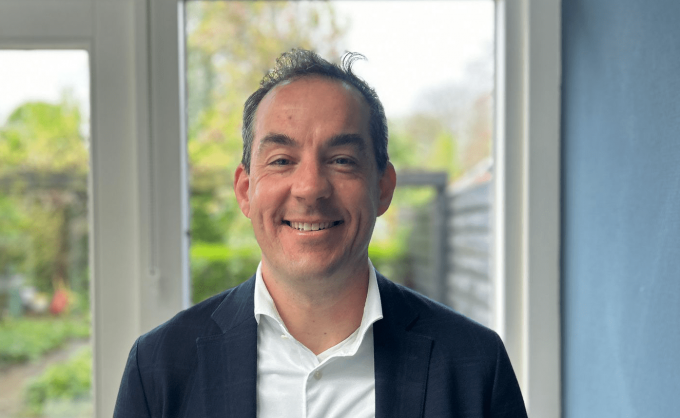Mega M&A not on the menu for 'One UPS' – but it has a plan
Over two long hours with UPS

Dutch shipowner WEC Lines is undergoing “open heart surgery” in its goal to combine shipping and logistics, recently appointed CEO Caesar Luikenaar (above) told The Loadstar.
WEC Lines has remained focused on its role as a shipping line throughout its 50-year existence, currently seeing some 80% of its turnover from shortsea feeder operations in Europe, while niche services in the Africa region, focusing on commodity trades, account for the remaining 20%.
However, the line is now looking to “stand on its own legs”, to gain more control over the cargo it carries and sharpen its competitive edge as it evolves into a logistics provider, he says.
“Customers want to know more about where the container is, and what time the container was delivered. It’s not only from port to port, but you need to see it door to door. So we must put a little bit more emphasis on that,” explains Mr Luikenaar.
The Rotterdam-based company recently changed its logo, to reflect “an open, approachable attitude and a fresh outlook”, says Mr Luikenaar, appointed its CEO in July.
Having started his career in the Dutch navy, followed by a 14-year tenure at multimodal logistics company Samskip in various roles, Mr Luikenaar boasts an eclectic amalgamation of experience that he says makes him well equipped to head WEC’s voyage into new territory.
He is “dusting off the company” to realise WEC Lines’ ambitious development goals. But re-jigging an operational structure that dates back more than 50 years will be no mean feat, says Mr Luikenaar.
“If you get a load list to load on a container vessel with thousands of containers and they are one colour, it’s very easy. You need one ship planner, you can buy or charter a ship for it, it sails and then comes back.
“But if you have to fill a ship with thousands of containers of all different colours – one shipper has 25, one has 30 and one has a 50, say, you can understand that the sales organisation and corporate structure you need is a little bit different. It is, in essence, a different organisation.” he says.
One of the main changes WEC Lines is making, he reveals, is getting more involved in the intermodal connections linked to its vessel network, predominately in Southern Europe.
“Spain has been very positive for us. North Spain, Bilbao, has a big hinterland and, if you want to make your hinterland bigger, you need rail.”
But, he warns, “you need to be smart” in how you establish intermodal expansion.
“The challenge of rail is that it’s very asset-heavy, it’s very fixed cost-ish and it brings you almost an extra cost, like a ship. It’s also very rigid, once you’re on a rail track you can’t go anywhere and you need it to run.
“So, if you have a storm and trees fall over… at least with a ship you can steer to another port,” he laughs.
And even though WEC has dropped the iconic vessel from its logo, to signify its shift from purely ocean offerings, Mr Luikenaar insists the line isn’t sailing too far from home.
“Our DNA is that we are a shipping line, and I think we are good at that. You must watch out that you don’t get caught up in trying to become a rail operator, because that can cost a lot of money.” It is about working with the right partners, he adds.
The company’s geographical expansion and voyage into door-to-door logistics has seen it attract a larger and different customer base.
“The type of customer, of course, is changing, because before this, WEC Lines was not very active with big shippers with tenders. Now we have a huge tender calendar, maybe over 350. Basically, every day there is a tender, so the volumes are a bit bigger.
“When you sell to a lot of local smaller customers or forwarders it’s easier, because with a local relationship you xan have lunch together and maybe you’re already there. But this is a completely different business. You must deal with people, with Excel sheets and performance.
“But if you want to grow, you need to be in that segment.
“There is more to comply with. More punctuality, more track and trace, regulatory compliance and sustainability demands. So, it will put different demands on your organisation, and thus the need for different manpower,” he says, adding that decarbonisation demands have also moved up the corporate agenda.
“We are working hard towards reaching net-zero emissions in 2050 by retrofitting our entire fleet. For instance, our vessel WEC Van Eyck is in dry dock to obtain a new hybrid loop scrubber system to clean the exhaust gases from sulphur oxide emissions. Other efforts are also in process.”
As WEC strives to strike the balance between its core shipping business and its new integrated logistics venture, smooth sailing was never going to be on the horizon, says Mr Luikenaar, but he’s optimistic about reaching the destination.
“We are a very healthy company with a healthy basis, but we need to reorganise a little bit to be ready for expansion. We are already doing some expansion, such as a new direct service between Agadir, Portugal, Spain and the UK, as well as our venture into temperature-controlled transport, serving as an alternative to overland trucking for fresh produce importers.
“But we have a few growing pains, so we are doing a little bit of open-heart surgery to be able to do the right things and have profitable growth.”
Comment on this article